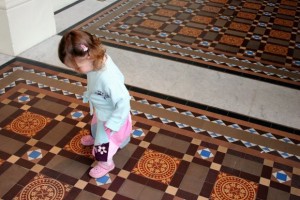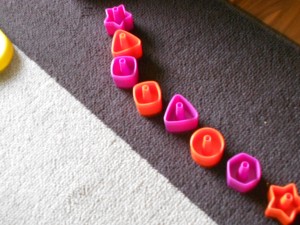From the wolf in Little Red Riding Hood and other stories, kids hear about the advantage of a short-cut. Patterning skills are a short-cut for learning.
 Pattern recognition is the ability to see a pattern in a vast amount of information. Our homes have countless patterns in tiles on walls and floors, blankets, and dishes. Our lives follow the pattern or routine of getting up in the morning, daily activities and meals, and going to bed at night. Patterns can be found:
Pattern recognition is the ability to see a pattern in a vast amount of information. Our homes have countless patterns in tiles on walls and floors, blankets, and dishes. Our lives follow the pattern or routine of getting up in the morning, daily activities and meals, and going to bed at night. Patterns can be found:
- in actions–walking is left, right, left, right,
- in our language–sentences follow a similar order,
- in nature–day, night, day, night,
- in numbers–1 to 10 repeats over and over.
Patterns reduce the amount of information we need to process and remember. They are often a short cut to learning. Because the brain grows so much and so fast during the early years, helping children to develop skills with patterns helps them, like the wolf, get there first.
 As children play, we may notice a pattern or help them make one with their toys. Blocks can be piled in a pattern of colors: red, blue, red, blue, and so on. Cars can be attached to a train using patterns.
As children play, we may notice a pattern or help them make one with their toys. Blocks can be piled in a pattern of colors: red, blue, red, blue, and so on. Cars can be attached to a train using patterns.
Often, exercises will be done in a pattern like arms up, arms down, arms up, arms down, etc. We play music and sing songs with patterns. Many children’s books will also have patterns, such as words that rhyme, actions that happen over and over, or numbers that get bigger and bigger.
 Many articles of clothing will have stripes or other patterns as well as places around the house. Outside, kids can look for patterns on the sidewalk, in buildings, and tell us what they see. On a nature walk look for patterns. Trees have a series of rings that get bigger and bigger and sometimes we can see these in a log.
Many articles of clothing will have stripes or other patterns as well as places around the house. Outside, kids can look for patterns on the sidewalk, in buildings, and tell us what they see. On a nature walk look for patterns. Trees have a series of rings that get bigger and bigger and sometimes we can see these in a log.
An article by Matt Powers, How Learning Patterns Leads to Brighter Children, explains how patterns also helps social skills. Kids use patterning skills to predict behavior and respond to others. Pattern recognition is seen as advantageous for business leaders as they pick out trends and make decisions.
For a play-of-the-day, can your child have some fun with patterns?
